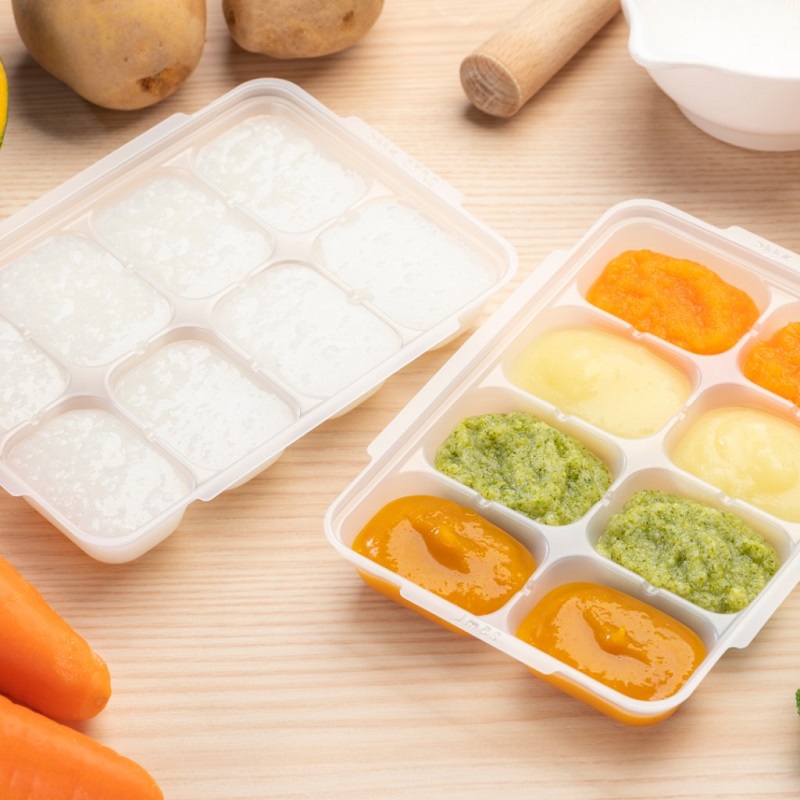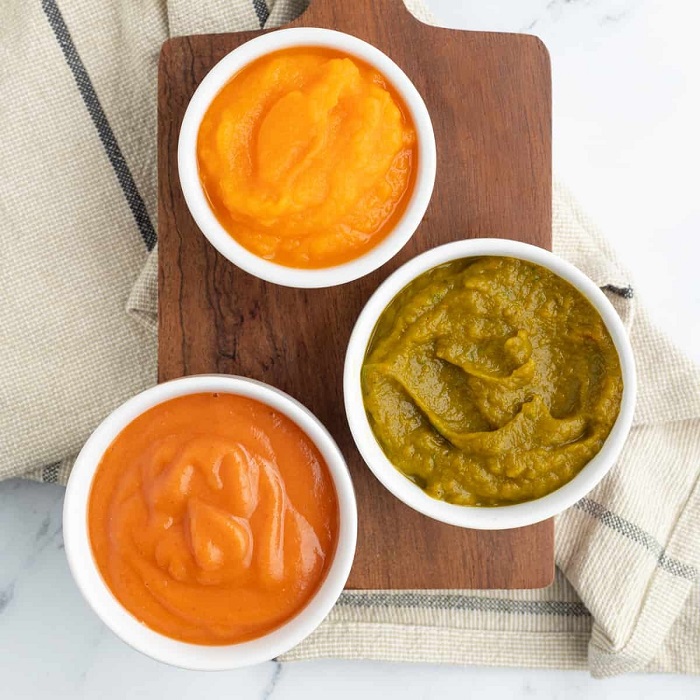Introduction to Baby Food Storage
Proper storage extends baby food’s freshness. It is crucial for health and convenience. Knowing how long does baby food last helps prevent waste. Plus, it ensures nutrients stay intact. Homemade baby food offers control over what your baby eats. Commercial products have clear expiry dates and are convenient. But homemade food needs careful handling. Today, we share storage guidelines for baby food. This keeps it tasty and safe. Fridge or freezer? Jarred or pouches? We cover it all. Learn how to store baby food for maximum freshness. Ensuring your baby gets the best is a top priority.
Benefits of Homemade Baby Food
Preparing baby food at home can be a rewarding process. It allows parents to select fresh, high-quality ingredients and create meals tailored to their baby’s developing taste buds. Let’s explore why homemade baby food can be a better option compared to store-bought varieties.
Economical and Nutritional Advantages
Creating baby food in your kitchen gives you budget-friendly and nutritious benefits. By purchasing fresh produce in bulk, you can save money compared to the cost of pre-packaged jars and pouches. More importantly, homemade baby food does not contain preservatives or additives, making it a wholesome choice for your little one. This hands-on approach also preserves more nutrients since the food is prepared and served fresh.
Moreover, when freezing homemade purees, you produce greater amounts of food. This not only reduces shopping trips but also gives you a stock of healthy options at hand. With control over portion sizes, you can also minimize waste, ensuring how long does baby food lasts is both economical and efficient.
Control Over Ingredients
When you make your baby’s food, you gain full control over what goes into each meal. This means you can avoid allergens and ingredients that may not suit your baby’s needs. It allows for the introduction of various flavors and textures at your own pace. Dietary restrictions or preferences, such as vegetarian or organic, can be easily accommodated.
You control the balance of fruits and veggies, which is essential for proper nutrition. By being aware of each ingredient, you track your baby’s intake and adjust as needed. Preparing baby food at home also allows you to ensure freshness, as there’s no guessing about expiry dates – you know exactly when and how long the food can last. This is a major plus for conscientious parents dedicated to providing the best for their baby’s health and development.
Storing Homemade Baby Food

Proper storage is key for keeping homemade baby food fresh and safe. Let’s dive into the best practices for refrigerating and freezing these nutritious meals for your infant.
Refrigeration Guidelines
For freshness, consume refrigerated homemade baby food within 48 hours. Promptly refrigerate purees after preparation to retain nutrients. Use clear containers to monitor contents and label with preparation dates. Avoid feeding your baby from the storage container to prevent bacteria from saliva contaminating the leftovers. Instead, portion out what’s needed into a separate dish for feeding.
Freezing Methods and Tips
Freezing extends how long baby food lasts. Store purees in small quantities, making them easier to thaw. Ice cube trays are ideal for freezing one-ounce portions. After freezing, transfer the cubes into labeled freezer bags. Ensure the labels display the food type and freeze date. When filling containers or pouches, leave space for expansion during freezing. Always use freezer-safe materials to prevent chemical leaching. Baby food frozen properly can last from 3 to 6 months, ensuring a continuous supply of healthy meals for your little one.
Using Baby Food Pouches
Baby food pouches offer a portable, user-friendly option for busy parents. The pouches make it easy to feed babies on the go. You can choose from various types of pouches to suit your needs. Manage portions and maintain freshness using these convenient storage options.
Benefits of Using Squeeze Station
Using the Squeeze Station simplifies the process of filling baby food pouches. It’s quick and avoids messes. This gadget allows parents to prepare healthy food in advance. You can store these pouches in the fridge or freezer, maintaining freshness. Baby food made this way retains its taste and nutrients.
Types of Pouches Available
There are several types of pouches available. Disposable ones are single-use and come with their own caps. Reusable pouches can be washed and reused, reducing waste. Both types are safe for storing baby food. They are BPA, PVC, and phthalate free. Choose based on your preference for convenience and environmental impact.
Safety Tips for Baby Food Storage

When it comes to storing it, safety is paramount. To ensure your baby’s health and prevent foodborne illnesses, it is essential to follow key safety tips. Here, we outline crucial measures to prevent contamination and recognize when food has spoiled.
Preventing Contamination
Preventing contamination is a two-fold process – it involves both the preparation and storage phases. Here are steps to ensure purees remain safe:
- Always wash your hands before preparing it.
- Use clean cutting boards, blenders, and utensils.
- Avoid feeding from storage containers to stop saliva from mixing in.
- Pour only the needed amount of food into a separate bowl for feeding.
- Label homemade with the preparation date before storing.
- Discard any food that has come into contact with a used spoon or baby’s mouth.
- Keep the fridge at the right temperature, usually below 40°F (4°C), for optimal preservation.
These habits minimize the risk of bacteria entering and spreading in it.
Recognizing Spoilage Signs
Spotting spoiled it is crucial to keep your baby safe. Here are signs to watch for:
- Strange odors indicate bacterial growth.
- Mold presence, usually seen as fuzzy spots of various colors.
- Separation or watery consistency can suggest spoilage.
- Changes in color may denote that food is past its prime.
- Containers that are bulging or leaking are signs of spoilage or contamination.
It’s important to rely on your senses to prevent feeding spoiled food to your baby. When in doubt, it’s best to throw it out. Keeping these safety tips in mind when storing homemade one will ensure your baby enjoys fresh, nutritious meals without the risk of getting sick.
Shelf Life of Commercial Baby Food

When it comes to fresh food, proper storage is essential. For it, both pre-packaged and homemade versions have different shelf lives. Understanding these can help ensure the food fed to your baby is both fresh and safe.
Store-Bought vs. Homemade Lifespan
Store-bought it usually has a longer shelf life compared to homemade. Packaged in sterile conditions, these products often contain preservatives that extend their usability. Typically, unopened store-bought it can last for months until its printed expiry date.
Once opened, however, it should be handled carefully. Store it in the fridge, and use within 48 hours, as recommended by safety guidelines. Do not feed your baby directly from the container as saliva can contaminate the remaining contents.
Homemade one, free from preservatives, generally has a shorter shelf life. It should be consumed within 48 hours if stored in the fridge, and can last 3 to 6 months in the freezer. Remember to label homemade one with the date of preparation before refrigeration or freezing.
Choosing between homemade and store-bought involves considering convenience, cost, and how long you need the food to last. Remember, the freshness of baby food directly impacts its nutritional value and safety.
Thawing and Reheating Baby Food
Properly thawing and reheating it ensures it remains safe and nutritious. These processes maintain food quality for your baby’s consumption.
Safe Thawing Practices
Thawing it correctly prevents bacterial growth. Always avoid leaving it to thaw at room temperature. Instead, thaw it overnight in the refrigerator. Planning helps manage thawing time effectively. Another method involves using the microwave. Set it to the defrost setting. Check the food’s temperature to ensure even warmth throughout.
Reheating Recommendations
Reheat only the needed amount of it. Use a microwave or stovetop for best results. Stir food during reheating to distribute heat evenly. Always test the temperature before feeding your baby. Avoid reheating the same portion more than once. Discard any leftovers from a reheated meal to ensure safety.